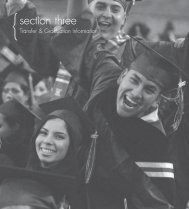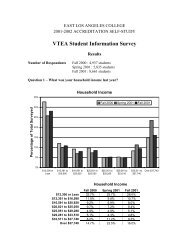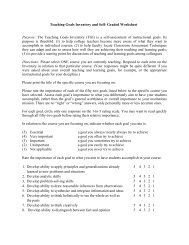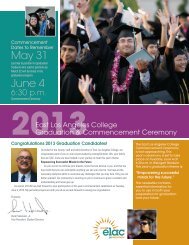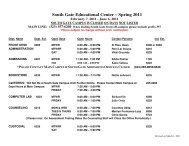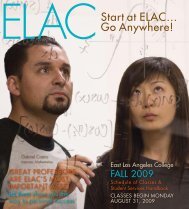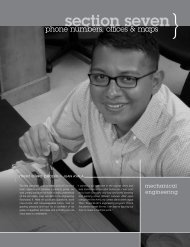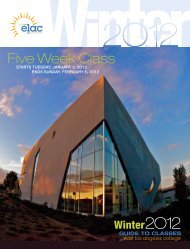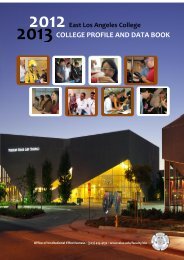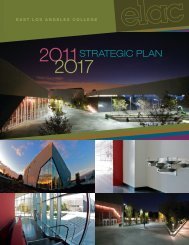Introduction - East Los Angeles College
Introduction - East Los Angeles College
Introduction - East Los Angeles College
- No tags were found...
Create successful ePaper yourself
Turn your PDF publications into a flip-book with our unique Google optimized e-Paper software.
east los angeles collegeAccreditation Self Study 2009Start at ELAC…Go Anywhere!Accreditation Self Study 2008.indd 112/8/08 9:16:42 AM
introductionmeet elac peopleWendy VargasComputer Applications &Office Technologies“If I could change the past, I would havestarted ELAC as soon as I graduatedfrom high school. I felt I had to get a jobas quickly as possible to help my family.I have learned how important educationis. The academic courses were tough forme, but I used all the special help thecollege provides. The library, writingcenter and math lab helped me getthrough the academic classes. I liked theCAOT computer lab so much that I”was able to get a job tutoring there.Start at ELAC…Go Anywhere!Accreditation Self Study 2008.indd 312/8/08 9:16:48 AM
INTRODUCTION<strong>College</strong> History<strong>East</strong> <strong>Los</strong> <strong>Angeles</strong> Junior <strong>College</strong> was established in June 1945 by the <strong>Los</strong> <strong>Angeles</strong> CityBoard of Education. The college opened its doors for the fall 1945 semester in September ina wing of Garfield High School boasting 19 faculty members and 380 students, most ofwhom were World War II veterans.The college quickly outgrew the borrowed high school facilities. In 1947, the Board ofEducation was able to purchase 82 acres of agricultural land thanks to funding from a bondissue. Two years later in January 1949, classes began at its present location in woodenbungalows moved to the campus from the Santa Ana Army Base. More than nineteenhundred students enrolled that year.An evening program begun in 1947 was expanded and offered at many locations. By 1954,the popular program offered classes at 25 different locations. The Civic Center programalone enrolled 1,927 students that year.In 1948 a name change was proposed. <strong>Angeles</strong> Bella Vista <strong>College</strong>, Ramona Hills <strong>College</strong>and Hillview <strong>College</strong> were considered. The following year “Junior” was dropped and thename <strong>East</strong> <strong>Los</strong> <strong>Angeles</strong> <strong>College</strong> (ELAC) was firmly established.Permanent buildings were constructed to accommodate growing enrollment. In 1951 thestadium and auditorium were built. More classrooms, an administration building, library,planetarium, men’s and women’s gyms, a swim stadium, theatre, and art gallery followed.Today ELAC boasts the Vincent Price Art Museum, which houses the largest and mostvaluable art collection in a two-year college thanks to donations and support from actorVincent Price.During the 1960s and 1970s, buildings to house the nursing program, a new library, and laterthe automobile technology center were added to the campus. Many of the original bungalowswere still used as classrooms until 2007 when they were finally demolished to make way fornew campus structures.In 1969 the California State Legislature clearly defined higher education in the state andseparated the (then) eight community colleges of the <strong>Los</strong> <strong>Angeles</strong> Unified School Districtand formed the <strong>Los</strong> <strong>Angeles</strong> Community <strong>College</strong> District. A seven-member Board ofTrustees was elected to govern the new district. The ELAC service area was defined toinclude the communities of Alhambra, Bell, Bell Gardens, City of Commerce, Cudahy, <strong>East</strong><strong>Introduction</strong> Page 1
<strong>Los</strong> <strong>Angeles</strong>, Huntington Park, <strong>Los</strong> <strong>Angeles</strong>, Maywood, Montebello, Monterey Park,Rosemead, San Gabriel, South San Gabriel, South Gate and Vernon.In 1972 the City of Monterey Park annexed the college and surrounding neighborhood,officially changing the main campus address. ELAC began growing, adding facultymembers, programs and classes as demand for higher education increased.ELAC hosted swimming and field hockey events during the 1984 Olympics, welcomingthousands of spectators to campus and increasing the international visibility of the college.Despite funding challenges that limited growth during the 1980s, ELAC continued to offer avariety of vocational and transfer programs.During the 1990s ELAC experienced unprecedented changes. Enrollment grew from 13,000to approximately 30,000 students and the number of permanent faculty almost doubled.Outreach programs were located throughout the service area for the convenience of studentswho could not easily travel to the main campus. The full-service South Gate EducationalCenter was established in the southern part of the service area so students could complete atransfer program and several career programs without attending the main campus. In 2007, athird site was opened in Rosemead to serve students in the northeastern portion of ELAC’sservice area.Growth during the first decade of the 21 st century was not limited to increasing enrollment.An emphasis on student-centered education and providing support that engendered studentsuccess increased ELAC’s graduation numbers. Since 2000, <strong>East</strong> <strong>Los</strong> <strong>Angeles</strong> <strong>College</strong> hasgraduated the highest number of Latinos in California and has consistently been listed as oneof the top 100 colleges nationally for exceptional graduation rates by Community <strong>College</strong>Week, a trade paper reporting on community colleges in the United States.Two bond issues, Propositions A and AA, initiated by the LACCD were approved by votersat the beginning of 2000. Funding of over $281,000 allowed ELAC to begin the mostambitious building program in its history to substantially improve the college’sinfrastructure. A state-of-the-art technology building, started with state funds, opened in fall2004 showcasing the first of many buildings and improvements that are planned or underconstruction.By 2008, completed projects include a renovation of the Helen Miller Bailey Library, arefurbished stadium, a new baseball diamond and facility, and numerous upgrades to existingbuildings and grounds. Many other projects are underway. The front of campus is undergoingtotal renovation. A parking structure that will provide more than 1,800 spaces is scheduled to<strong>Introduction</strong> Page 2
open spring 2009 followed by a remodeled Student Center, main entrance plaza, the Library,and Administration Building the following year.The three-building Visual and Performing Arts Complex was begun in fall 2008. Located atthe east side of the campus, the complex will house the Vincent Price Art Museum as well astheatres, labs, classrooms and studios for art, music, dance and theatre programs. Completionis scheduled for 2010.In November 2008, the voters passed a third bond, Bond J, for additional construction. Plansfor a Math and Science Building, gardens, plazas, and additional classrooms are movingtoward approval and construction. Building is scheduled to continue for the next decade.When completed, <strong>East</strong> <strong>Los</strong> <strong>Angeles</strong> <strong>College</strong> will be positioned to provide the education andservices our students and community so richly deserve.<strong>College</strong> and Community Profile<strong>East</strong> <strong>Los</strong> <strong>Angeles</strong> <strong>College</strong> is a large community college with over 58,000 enrollment eachsemester. Our academic, career technical, noncredit, and In-service Training Academiesserve more than 30,000 students representing 22,250 full-time equivalent students. Thecommunities served by ELAC include those immediately surrounding the college’s maincampus in Monterey Park and surrounding its Rosemead and South Gate EducationalCenters. The college’s service area has a population of over 1.5 million people and isexpected to grow at a rate faster that the District, County, State, and the United States. Inaddition, current population estimates report that over 40 percent of the ELAC population isunder the age of 25. The combined growth and age data support a robust population in needof academic and career technical services.<strong>East</strong> <strong>Los</strong> <strong>Angeles</strong> <strong>College</strong>(ELAC)<strong>Los</strong> <strong>Angeles</strong> Community<strong>College</strong> District (LACCD)2008EstimatedPopulation2015ProjectedPopulation1,522,314 1,610,339 88,025 5.85,284,641 5,468,068 183,427 3.5%<strong>Los</strong> <strong>Angeles</strong> County (LA Co.) 10,116,810 10,452,926 336,116 3.3California (CA) 37,338,070 39,109,364 1,771,294 4.7United States of America(USA)305,330,264 317,237,948 11,907,684 3.9<strong>Introduction</strong> Page 3
A cursory investigation of our service area has shown some notable findings, including thefact that there are more than 50,000 households below the poverty line in our community.Conditions created by poverty will require the college to increase psychosocial support tostudents through ancillary services while they are working toward their educational goals.This support will include increasing the accessibility of student services such as financial aid.In addition, it will be necessary to investigate the occupational needs of our community andwork to provide programs that develop well qualified students to fill positions that are in highdemand. The Education Plan seeks to address these issues in a comprehensive mannerthrough goals to improve educational opportunities and access, student success and planningaccountability and service.2008 - Estimated PopulationELAC LACCD LA Co.N % N % N %African-American 40,680 2.7 506,955 9.6 871,692 8.6Asian 219,751 14.4 666,814 12.6 1,341,091 13.3Caucasian 100,520 6.6 1,360,357 25.7 2,863,594 28.3Hispanic 1,139,678 74.9 2,640,374 50.0 4,835,012 47.8Others 21,686 1.4 110,141 2.1 205,419 2.0Total 1,522,315 100.0 5,284,641 100.0 10,116,808 100.0Data on <strong>Los</strong> <strong>Angeles</strong> County educational attainment further exemplifies the need for highereducation in the ELAC service area. Approximately a quarter of <strong>Los</strong> <strong>Angeles</strong> Countyresidents never received a high school diploma and an additional 38.7% report completinghigh school as their highest level of education. These figures are less dramatic in the studentpopulation with only 5.8% of students reporting never having attained a high school diploma.The student body population is predominantly Hispanic or Latino, with Asian or AsianPacific Islanders representing the second largest demographic Group on campus. The ethnicdemographics of the student body have remained relatively unchanged over the past fiveyears and are representative of the general community in the ELAC service area with a slightunder representation of Caucasian and African American students.75%African-AmericanAsian20%1%2%2%HispanicWhiteOther62%38%FemaleMaleDemographic data excludes In-service Training Academies<strong>Introduction</strong> Page 4
ELAC has shown excellent outcomes on the District and VTEA core indicators. ELAC hasthe higher Fall to Fall persistence rates than most schools in the district and is above theDistrict average in ARCC measures of Basic Skills improvement rates and rates of studentsearning more than 30 units. In addition, the college has made significant gains in rates ofstudent progress and achievement. ELAC is also the highest rated college in the District interms of institutional efficiency. VTEA core indicators demonstrate that ELAC is excellingbeyond the state average on most measures of effectiveness.StatePerformanceLevel Goal (%)StatewidePerformanceLevel (%)2006 – 2007LACCDPerformanceLevel (%)ELACPerformanceLevel (%)SkillAttainment78.8 76.4 82.1 88.5Completions 59.8 74.4 81.4 83.1Placement 83.2 82.6 81.5 84.4Retention inEmploymentNon-TraditionalParticipationNon-TraditionalCompleter82.8 82.9 83.6 86.729.0 37.9 38.9 33.627.0 35.8 46.5 46.9ELAC serves a diverse community through its academic, career technical and non-creditprogramming. State, District and college indicators show many areas in which the college iscurrently excelling. <strong>College</strong> leadership is involved in the review of college data and hasworked to plan for the needs of students, including offering vocational and basic skillscurriculum that meets the needs of the current student body and the general community.<strong>Introduction</strong> Page 8
<strong>College</strong> Organizational Structure<strong>East</strong> <strong>Los</strong> <strong>Angeles</strong> <strong>College</strong>Ernest H. Moreno, PresidentVice PresidentAdministrativeServicesRobert IsomotoVice PresidentAcademic AffairsRichard A. MoyerVice PresidentWorkforce Edu. &Economic Devel.Reneé MartinezVice PresidentStudent ServicesOscar ValerianoPresident - Functions:<strong>College</strong> Budget<strong>College</strong> Governance (Committees, Policies &Procedures, Structure)<strong>College</strong> Image<strong>College</strong> Liaison with Chancellor’s Cabinet<strong>College</strong> Representation to Governing Board(including <strong>College</strong> agenda items)<strong>College</strong>-Wide PlanningCommunity RelationsEducational Facilities Master PlansPersonnelPublic Information (including coordination withDistrict)Committee Responsibilities:President’s CabinetExtended President’s CabinetAdministrative CouncilPlanning & Budget CouncilFacilities CommitteeMarketing/Recruitment Committee<strong>Introduction</strong> Page 9
Academic AffairsDr. Richard A. Moyer, Vice PresidentFunctions:Dean,Liberal ArtsKaren DaarDean,Liberal ArtsVi LyDean,Liberal ArtsKerrin McMahanDean,South GateAl RiosAcademic Master PlansAccreditation Liaison OfficerChief Instructional Officer<strong>College</strong> Coordinator for Reassigned TimeCurriculum Articulation within District (JCAC)Curriculum Oversight (new program development & revision inconjunction with deans)Educational Policies and ProceduresFaculty Staffing Recommendations (through deans)Faculty (reporting through chairs/coordinators and deans)Coordination of Prerequisite enforcement (co-responsibility withVP Student Services)Oversight and Approval of <strong>College</strong> Class Schedule and CatalogTutoring (through deans)Faculty Collective Bargaining/Administrative RepresentativeOversight of Faculty Evaluation (through deans)Instructional Operations: rooms, class schedule, catalog,curriculum, enrollment dataMonitor educational Policy/Procedure ComplianceCommittee Responsibilities:Work Environment CommitteeStudent Learning OutcomesStudent SuccessMatriculationTransfer CommitteeDepartment ChairsDistrict Committee: Vice Presidents Council<strong>Introduction</strong> Page 10
Dean, Liberal ArtsKaren DaarDean, Liberal ArtsVi LyDean, Liberal ArtsKerrin McMahanDean, South GateAl RiosChairs/Coordinators:ChemistryEnglishLife SciencesPhysicsSocial SciencesChairs/Coordinators:ArtMusicPhilosophyPhysical Edu. – MenPhysical Edu. – WomenSpeech/TheatreChairs/Coordinators:Anthro/Geol/Geog/Int. TradeChicano StudiesForeign LanguagesMathematicsPsychologyOther:Learning Assistance CenterMente LabDistance EducationScheduleMove LiaisonCOMMON DIVISION DEAN FUNCTIONS*Planning: Development, revisionFaculty, Classified Staffing: Proposal development, recruitment, selection, orientation, assignment, supervision evaluationBudget: Development, administrationCurriculum: Development, revision, articulation with K-12 and universityClass schedule: Development and administrationExternal resource developmentDiscipline labs/centers supervision*with chairs, faculty and subordinate administrators, as appropriatePosition-specific Functions:CatalogCurriculumEducational Planning Com.Degree AuditMatriculationStudent Learning OutcomesTransfer CommitteePosition-specific Functions:PACEPlanning for Art ComplexPosition-specific Functions:Distance EducationTechnology PlanningCommitteePosition-specific Functions:Off Site Committee<strong>Introduction</strong> Page 11
Workforce Education & Economic DevelopmentMs. Reneé Martinez, Vice PresidentFunctions:Dean,Career Technical Edu.Laura M. RamirezDean,Continuing Edu.Adrienne Ann MullenDean,Academic Affairs &Economic Devel.Gayle BrosseauAssoc. Dean,CalWORKsAngelica ToledoAcademic Master PlansChief Instructional Officer<strong>College</strong> Coordinator for Reassigned TimeCurriculum Articulation within District (JCAC)Curriculum Oversight (new program development & revision in conjunction with deans)Educational Policies and ProceduresFaculty Staffing Recommendations (through deans)Faculty (reporting through chairs/coordinators and deans)New full-time faculty orientationCoordination of Prerequisite enforcement (co-responsibility with VP Student Services)Oversight and Approval of <strong>College</strong> Class Schedule and CatalogTutoring (reporting through Associate Dean)Instruction budget developmentFaculty Collective Bargaining/Administrative RepresentativeOversight of Faculty Evaluation (through deans)Instructional Operations: rooms, class schedule, catalog, curriculum, enrollment dataMonitor educational Policy/Procedure ComplianceAdjunct faculty professional developmentCommittee Responsibilities:Budget Committee • Career TechnicalMatriculation • Work Environment CommitteeTitle V • Transfer CommitteePlanning Committees: Facility, Educational, Off-Site, and TechnologyStudent Learning Outcomes Student SuccessDistrict Committees:CTE Deans • Vice Presidents CouncilHR Council • Nursing Task ForceProf. Dev. Task ForceOther Committees:Beverly Hospital: Board of Directors, Board Governance, Strategic PlanningCrystal Stairs Board<strong>Introduction</strong> Page 12
Dean, Career TechnicalEducationLaura M. RamirezChairs/Coordinators:Admin. of Justice/FireTech/EMTJournalismLife Sciences: HIT, Elec.Microscopy, Resp. TherapyNursingPhotographyDean, Continuing EducationAdrienne Ann MullenCoordinators:Community ServicesNon CreditBasic SkillsRosemead CenterSwap meetDean, Economic Dev.Gayle BrosseauChairs/Coordinators:ArchitectureAuto TechBusiness/CSITCFESCAOTElectronicsEngineeringLibraryAssociate Dean, CalWORKsAngelica ToledoOther:RCATMESAOther:Tech PrepCOMMON DIVISION DEAN FUNCTIONS*Planning: Development, revisionFaculty, Classified Staffing: Proposal development, recruitment, selection, orientation, assignment, supervision evaluationBudget: Development, administrationCurriculum: Development, revision, articulation with K-12 and universityClass schedule: Development and administrationExternal resource developmentDiscipline labs/centers supervision*with chairs, faculty and subordinate administrators, as appropriatePosition-specific Functions:Liaison with business andindustryVTEA budget: Development,administration, reportingJoint HiresMatriculationStudent Learning OutcomesState EquipmentPosition-specific Functions:LA/Orange DeansState EquipmentStudent SuccessTechnology Discussion Group<strong>Introduction</strong> Page 13
Student ServicesMr. Oscar Valeriano, Interim Vice PresidentRahmani VanterpoolAdministrative SecretaryJeremy AllredDeanAdmissions and RecordsDaniel OrnelasChairCounselingPaula PalominoDirectorUniversity CenterScholarshipsVacantDeanSuzette M-GuerraCounselorMatriculationMichael SimoneDirectorChild Development CenterJanet HuangCounselorCareer/Job CenterDanelle FallertAssociate DeanEOPSSonia LopezAssociate DeanStudent ActivitiesAssessmentVacantAssociate DeanOutreach and RecruitmentStudent Health CenterGrace HernandezDisability SpecialistDSPSInternational StudentsLindy FongManagerFinancial Aid<strong>Introduction</strong> Page 14
Administrative ServicesMr. Robert G. Isomoto, Vice PresidentAdministrative AssistantCivic Center PermitsSusan OkawaSenior Office AssistantMonica De La ParraAdministrative AideApril AragonAssociate Vice PresidentAdministrative ServicesErlinda De OcampoAssociate Vice PresidentAdministrative ServicesTom FurukawaFacilitie ManagerRichard GuyInfo Tech ManagerGonzalo MendozaDeputyL. A. County SherrifJose GarciaSPOCOffice SupervisorOperations ManagerSenior Office Asst.Norman CheungBrundo De SilvaJohn TurnerClaire Figueroa<strong>Introduction</strong> Page 15
LOS ANGELES COMMUNITY COLLEGE DISTRICTBoard of TrusteesOrganizational StructureBoard of TrusteeMemberMs Georgia MercerBoard of TrusteesMemberMs Nancy PerlmanBoard of TrusteesMemberMs Angela ReddockBoard of TrusteesPresidentMr Kelly CandaeleBoard of TrusteesVice PresidentMs Mona FieldBoard of TrusteesMemberMr Miguel SantiagoBoard of TrusteesMemberMs Sylvia Scott - HayesBoard of TrusteesStudent TrusteeMs Rosemarie BustosPersonnelCommissionChancellorDr . Marshall E . Drummond( See Org Chart )Prepared by Human Resources – Data AnalysisAs of 29 August 2008<strong>Introduction</strong> Page 16
LOS ANGELES COMMUNITY COLLEGE DISTRICTOffice of the ChancellorOrganizational StructureChancellorDr. Marshall E.DrummondCounselor on Loan toDept. of HomelandSecurityMr. F. QuiambaoDeputy ChancellorDr. A. BarreraChief FinancialOfficer/TreasurerMs. J. GordonGeneral CounselMs. C. GouletVice Chancellor forEducationalSupport ServicesMr. J. ClerxExecutive Secretaryto the ChancellorMs. M. E. JaureguiExecutive DirectorFacilities Planningand DevelopmentMr. L. EisenbergVice Chancellor forEconomic andWorkforceDevelopmentMr. M. MartinezVice Chancellor forInstitutionalEffectivenessMr. G. ColomboAssistant Secretaryto the ChancellorMs. J. Hughes-FieldsCity <strong>College</strong>PresidentDr. J. Moore<strong>East</strong> LA <strong>College</strong>PresidentMr. E. MorenoHarbor <strong>College</strong>PresidentDr. L. SpinkMission <strong>College</strong>PresidentDr. J.VallesPierce <strong>College</strong>PresidentMr. R. GarberSouthwest<strong>College</strong>PresidentDr. J. Daniels, IIITrade-Tech<strong>College</strong>PresidentDr. R.ChapdelaineValley <strong>College</strong>PresidentDr. A. Carleo(Limited)WestLA <strong>College</strong>PresidentDr. M. Rocha= Unit Manager= SupervisorPrepared by Human Resources – Data AnalysisAs of 29 August 2008<strong>Introduction</strong> Page 17
Organization of the Self Study<strong>East</strong> <strong>Los</strong> <strong>Angeles</strong> <strong>College</strong> (ELAC) is pleased to submit this Institutional Self Study forReaffirmation of Accreditation. Formal planning for this study began in spring 2007 with theselection of the faculty self study chair by the college president and the Accreditation LiaisonOfficer (ALO) and approval by the Academic Senate. The organizational structure for the selfstudy was developed during summer 2007 for implementation during fall 2007. During fall 2008,an administrative co-chair assisted in the completion of the self study.Training for the Self Study ProcessOn February 22, 2007, Dr. Barbara Beno and Jack Pond from the Accrediting Commissionprovided an all-day training session for members of the steering committee and standards cochairsfrom the three <strong>Los</strong> <strong>Angeles</strong> Community <strong>College</strong> District (LACCD) colleges (<strong>East</strong>,City, and Trade Tech) entering their self study year.A follow-up session for the three colleges, led by Gary Colombo, Vice Chancellor forInstitutional Effectiveness, was held on February 28, 2007. Representatives from the threeLACCD colleges that had previously completed their self studies discussed issues that theyfaced and presented tips for developing productive self studies.On June 5, 2007, over 50 committee members for the standards attended a half-day workshopconducted by the faculty co-chair on the self study process and the timeline for completion ofthe standards drafts. District representative, Gary Colombo, explained the role of the districtoffice in the process.Participation in the Self Study ProcessBy the Steering Committee. The Steering Committee, led by the self study co-chair and theAccreditation Liaison Officer and comprised of one co-chair from each of the four standards,the Dean of Planning, the Associate Dean of Research, and the SLO coordinator, wasestablished to oversee the process. The Steering Committee members communicatedregularly at meetings and via e-mail.By Standard Co-Chairs. The co-chairs for the four standards were selected by a campusleadership group, including the faculty self study co-chair, the ALO and vice president ofAcademic Affairs, the vice presidents of Workforce Education, and Administrative Services,and Student Services, and the Academic Senate president. The co-chairs were selected fromthree campus personnel groups, faculty, classified, and administrative. At least one facultymember and one classified employee or administrator was selected to co-chair each standard.By Committee Members. Communications inviting participation in the process werecirculated to all campus personnel via e-mail, the Weekly Bulletin, a newsletter, and flyers.The self study co-chair made presentations to the Academic Senate, the department chairs,and the <strong>East</strong> <strong>Los</strong> <strong>Angeles</strong> Shared Governance Council (ESGC), the primary sharedgovernance body. The Associate Dean of Students assisted in the effort to recruit students.Direct invitations were made to the officers and members of the Associated Student Union.Standards co-chairs also recruited committee members from faculty, staff, and students.<strong>Introduction</strong> Page 18
By the District. The LACCD Office of Institutional Effectiveness under the leadership ofVice Chancellor Gary Colombo assisted the college in the preparation of this self study byserving as the liaison for the district office. Vice Chancellor Colombo, assisted by Ms.Deborah Kaye, conducted a series of meetings (February, April, August, and December 2007and September 2008) which were attended by the co-chairs and ALOs for the self studies ofthe three colleges that are currently undergoing reaccreditation. These meetings wereinvaluable as they provided the three colleges with the opportunity to share information,speak with representatives from other district colleges who previously underwentreaccreditation, and learn more about the operation of the district. The Office was alsoinstrumental in the preparation of the functional map and presented the map to the collegesfor approval.The faculty co-chair and the ALO reported the college’s progress in the completion of theself study to the Board of Trustees’ Planning and Student Success Committee on September19, 2007, and June 11, 2008. The college presented the completed self study to the Board ofTrustees’ Planning and Student Success Committee for review and formal approval onDecember 17, 2008.Data Gathering for the Self StudyThe college researcher provided regional demographic and economic data, prepared andadministered a faculty/staff/administrator survey, produced a student and faculty profile, andprovided the data from the district-administered student survey. The researcher also assisted thecommittees in evaluating the data. Standard committee members interviewed appropriateindividuals and reviewed supporting documents to collect and verify the data presented in thisself study.Progress Reporting for the Self StudyAccreditation and self study progress are standing agenda items for the bi-monthly meetings ofthe <strong>East</strong> <strong>Los</strong> <strong>Angeles</strong> Shared Governance Council and the Academic Senate. All members of thevarious standard committees were in constant communication with one another and with the selfstudy co-chairs via e-mail as well as through meetings of the standards. Some committees choseto use the SharePoint Portal for reporting progress. Two newsletters were published.Campus-Wide Review of the Draft of the Self StudyThe drafts of the standards were available for review and comment from October 30 toDecember 1.Announcements about the availability of the self study for review were posted campus widein the Weekly Bulletin, via e-mail and the college Microsoft SharePoint portal, and in<strong>Introduction</strong> Page 19
presentations to the Academic Senate, the department chairs, and the Shared GovernanceCouncil.The drafts were posted on the SharePoint portal and distributed in hard copy to thedepartment chairs, to the Associated Student Union government, and other campusleadership. Hard copy could also be requested directly from the self study co-chairs.During the review period, three campus-wide discussion forums, two at midday during thecollege hour and one in the late afternoon before evening classes, were conducted in mid-November. The Academic Senate also held discussion at an all-faculty meeting on November25.Ultimately, individuals representing all segments of the college community participated directlyin the self study process, with many others participating by completing surveys related toaccreditation/college issues and reviewing the draft of the self study and participating in forumsbefore its publication.This self study report is the outcome of the dialogue that occurred throughout the abovedescribed process. The self study is recognized as an ongoing process and is a significant part ofthe college's long-term planning strategy. It will serve to strengthen the institution's directionsand decision-making processes for preparing its students to function efficiently and effectively ina rapidly changing world. It reflects an open and honest interpretation of the state of health of thecollege and the issues that confront the <strong>Los</strong> <strong>Angeles</strong> Community <strong>College</strong> District andconsequently the college.<strong>Introduction</strong> Page 20
ACCREDITATION SELF STUDY 2007-2008 STEERING COMMITTEEBrenda K. Baity, Self Study Faculty Co-chairAssociate Professor, Computer Applications & OfficeTechnologiesSelf Study Faculty Co-Chairbaitybk@elac.edu 265-8932Karen DaarDean, Academic Affairs (currently)Associate Professor, AnthropologyFormer Curriculum Chair & Standard II Co-chairdaarkl@elac.edu 415-5374Evelyn EscatiolaProfessional Development CoordinatorAFT Chapter Chair 2007-2008Standard IV Co-chairescatie@elac.edu 265-8757Ran GustAcquisitions LibrarianStandard I Co-chairgustrg@elac.edu 265-8628Richard GuyDirector, <strong>College</strong> FacilitiesStandard III Co-chairguyrm@elac.edu 265-8754Robert IsomotoInterim President (until April 2008)Vice President, Administrative Services (current)isomotorg@elac.edu 415-4110Veronica JaramilloAssistant Professor, ChemistrySLO Coordinator (2008-2009)jaramiv@elac.edu 265-8851Reneé MartinezVice President, Workforce Education and EconomicDevelopmentStandard IV Co-chairmartinrd@elac.edu 265-8973Ryan CornnerAssociate Dean, Researchcornnerr@elac.edu 265-8967Kerrin McMahan, Self Study Admin. Co-chairDean, Academic AffairsStandard I Co-chairMcMahakm@elac.edu 415-4135Ernest H. MorenoPresident (since April 2008)morenoeh@elac.edu 265-8662Richard A. Moyer,Accreditation Liaison OfficerVice President, Academic Affairsmoyerra@elac.edu 265-8678Leonor Perez (currently on sabbatical)Dean, Research and PlanningStandard I team memberperezlx@elac.edu 415-4138Anthony A. SamadAssociate Professor, Political ScienceSLO Coordinator (2006-2007)samadaa@elac.edu 265-8938Editing and Support StaffApril Aragon, Administrative ServicesOlga Barnes, President’s OfficePatrick Hauser, FacultySusan Okawa, Administrative ServicesStaff, Information Technology DepartmentDean Athans, Academic AffairsPatricia Glover, Graphic DesignCatalina Medina, President’s OfficeMelissa Rabago, Academic AffairsSharon Tate, Marketing DirectorAcknowledgementsSpecial thanks to District Office personnel, Gary Colombo, Vice Chancellor for InstitutionalEffectiveness, and Deborah Kaye, Self Study Liaison to the Cityside Schools.<strong>Introduction</strong> Page 21
certification of eligibility requirementsmeet elac peopleChristal HernandezAdministration of Justice/Forensics“It is fascinating to me that one smallpiece of evidence can be used to recreatea crime scene. When my teacher Ms.Cavannaugh lectures it doesn’t seem liketeaching—it’s more of a story and problemsthat we have to solve. She also helpsus to make connections, find informationand solve problems, even our personalones. ELAC has helped me in everyway—from financing my education to”helping me find a rewarding career.Start at ELAC…Go Anywhere!Accreditation Self Study 2008.indd 412/8/08 9:16:49 AM
ELIGIBILITY REQUIREMENTS FOR ACCREDITATION1. AUTHORITY. <strong>East</strong> <strong>Los</strong> <strong>Angeles</strong> <strong>College</strong>’s authority to operate as a degree grantinginstitution is the continuous accreditation by the Accrediting Commission for Communityand Junior <strong>College</strong>s of the Western Association of Schools and <strong>College</strong>s, an institutionalaccreditation body recognized by the Commission on Recognition of PostsecondaryAccreditation and the United States Department of Education. This authority is noted on theinside cover page of the college catalog.2. MISSION. The mission statement appears in campus publications and is the basis for alloperational efforts. The previous revision of the current college mission statement occurredin 1991; it was reaffirmed by the college in 1997, 2000, and 2003. The most recent revisionoccurred in 2008. It was evaluated by the Office of Institutional Planning and the college'sEducational Planning Subcommittee with input from all campus constituencies. It has beenapproved by the college Shared Governance Council and will be approved by the Board ofTrustees in early 2009.3. GOVERNING BOARD. An eight-member Board of Trustees, seven of whom are electedat large plus one student trustee, governs the nine-college <strong>Los</strong> <strong>Angeles</strong> Community <strong>College</strong>District. Trustees are elected to the Governing Board for four-year staggered terms from theentire district, which includes all of the <strong>Los</strong> <strong>Angeles</strong> Unified School District and several ofthe incorporated and unincorporated communities, within and adjoining the city of <strong>Los</strong><strong>Angeles</strong>. The student trustee, elected by the student body, serves a one-year term on theBoard, and acts on District business (except for closed session issues) in an advisorycapacity. No member of the Board of Trustees shall have any financial interest in anycontract or purchase order made by the Board (BR 7100.15). The Governing Board holdsmeetings twice a month. They are open to the public, with notices and agenda widely postedin advance. In order to be widely accessible to members of the large <strong>Los</strong> <strong>Angeles</strong>Community <strong>College</strong> District, the Board holds many of its meetings at the colleges. TheDistrict Academic Senate and the District’s seven bargaining units report to the Board on aregular basis.4. CHIEF EXECUTIVE OFFICER. The Chancellor of the <strong>Los</strong> <strong>Angeles</strong> Community <strong>College</strong>District is selected by the Governing Board. Dr. Marshall Drummond, Chancellor, is theDistrict’s chief executive officer whose primary responsibility is to the District. ThePresident of the college is selected by the Governing Board in consultation with theChancellor. The college’s chief executive officer, President Ernest H. Moreno, has servedhas served in this capacity since 1994, except for a 22-month period from June 2006 to April2008 to oversee the operation of another district college.5. ADMINISTRATIVE CAPACITY. The college administration is adequate in number,experience, and qualifications to provide appropriate administrative oversight. The collegeorganization charts appear in this Self Study.6. OPERATIONAL STATUS. <strong>East</strong> <strong>Los</strong> <strong>Angeles</strong> <strong>College</strong> (ELAC) is a comprehensive collegethat meets the varied educational needs of our community. Students are enrolled in a varietyEligibility Requirements Page 23
of courses that lead to certificates of completion for non-credit basic skills, certificates ofcompetency for non-credit vocational, certificates of achievement for state-approvedprograms of 12 or more units, skills certificates for non-state approved programs of 17.5units and under, associate degrees, transfer, and personal development.7. DEGREES. The majority of the college’s offerings are in programs that lead to degrees asdescribed in the college catalog. ELAC offers 28 Associate in Arts Degrees and 13Associate in Science Degrees.8. EDUCATIONAL PROGRAMS. The <strong>College</strong>’s educational programs are consistent withits mission, are based on recognized fields of study, are of sufficient content and length, andmaintain appropriate levels of quality and rigor for the degrees and programs offered. Basicskills courses in reading, writing, and mathematics help students develop the proficiencynecessary to advance to college-level curricula or to qualify for entry-level employment. Thecollege, led by the Student Success Committee, is currently attempting to create anidentifiable, official program to address the problem of academically underpreparedstudents. Those with limited English proficiency may enroll in ESL courses. CommunityServices provides valuable short-term courses for personal development, leisure, recreation,and special interest.9. ACADEMIC CREDIT. Academic credit is based on Title 5 – 55002 (Standards andCriteria for Courses and Classes) of the California Administrative Code.10. STUDENT LEARNING AND ACHIEVEMENT. <strong>East</strong> <strong>Los</strong> <strong>Angeles</strong> <strong>College</strong> defines andpublishes program educational objectives in course outlines, in the college catalog, inoccupational program brochures, and in instructional planning documents. All are reviewedand updated in accordance with Title 5 and district guidelines. The college has adoptedinstitutional core competencies that identify expected outcomes in the areas of academicskills, personal growth and enrichment, and cultural and global awareness. All units,academic disciplines, student services, and administrative, are developing program-level,course-level outcomes, and assessments. Currently, student success is measured by faculty,based on the successful completion of course objectives and student learning outcomeswhich are stated on the course syllabus. Course objectives are clearly stated on the courseoutline of record. Student learning outcomes appear as an addendum to the course outline ofrecord. All courses, regardless of mode of delivery or location, follow the same courseoutline of record.11. GENERAL EDUCATION. General education at <strong>East</strong> <strong>Los</strong> <strong>Angeles</strong> <strong>College</strong> is part of everydegree program and has been structured to ensure breadth of knowledge, promoteintellectual inquiry, demonstrate competence in writing and computational skills, and serveas an introduction to major areas of knowledge. Courses in general education meet thequality and rigor appropriate for higher education.12. ACADEMIC FREEDOM. The college abides by the policy on academic freedom stated inLACCD Board Rules (BR 1204.12) adopted in February 2006 and Article 4 of theLACCD/<strong>Los</strong> <strong>Angeles</strong> <strong>College</strong> Faculty Guild agreement, which states, “The Faculty shallEligibility Requirements Page 24
have the academic freedom to seek the truth and guarantee freedom of learning to thestudents.” The campus maintains an environment of intellectual freedom and independence.13. FACULTY. As of fall 2007, <strong>East</strong> <strong>Los</strong> <strong>Angeles</strong> <strong>College</strong> had over 260 full-time facultyincluding nineteen full-time counselors. In addition the college employs over 660 adjunctfaculty, working in a variety of positions within the academic and career technicaldepartments, Child Development Center, and the Counseling office. These full-time andadjunct faculty provide teaching and student support services for all of the educationalprograms at the institution in pursuit of the college mission. The college ensures the qualityof its instructional faculty through a comprehensive evaluative process during hiring andregular assessment of teaching effectiveness through faculty evaluations. The names,degrees, and year of hire for full-time faculty are listed in the college catalog. Informationon full-time hires occurring between catalog years and all adjunct are held in the personneloffice and in the SAP record keeping system. Faculty responsibilities are set forth in theFaculty Handbook and Adjunct Faculty Handbook and in the contract between the AmericanFederation of Teachers <strong>College</strong> Guild and the <strong>Los</strong> <strong>Angeles</strong> Community <strong>College</strong> District.Included in faculty responsibilities is the development and review of curriculum through thecollege’s curriculum review process and the assessment of student learning within theclassroom.14. STUDENT SERVICES. <strong>East</strong> <strong>Los</strong> <strong>Angeles</strong> <strong>College</strong> provides appropriate services tostudents and develops programs that meet the educational support needs of its diversestudent population. The college provides services in the following areas: Admissions andRecords, Articulation, Associated Student Union, Basic Skills/Citizenship/GED, Bookstore,CalWorks Program, Campus Food Services, Career/Job Placement Center, ChildDevelopment Center, <strong>College</strong> newspaper (Campus News), Community Services (non forcredit programs), Cooperative Agencies Resources to Education (CARE), CounselingDepartment, Cultural Activities, including The Vincent Price Art Museum, DisabledStudents Programs & Services, Enrollment Center, Extended Opportunity Program &Services, Financial Aid, Fiscal Office, Health Center, Honors Program, IntercollegiateAthletics, International Student Program, Learning Assistance Center, Library, LittleTheater, <strong>Los</strong> <strong>Angeles</strong> County Sheriff Services, Matriculation, Mentor Program, MESAProgram, Puente Program, Scholarships, South Gate Educational Center, Student Center,University Center, and Veterans Services.15. ADMISSIONS. <strong>College</strong> admissions policies are consistent with its mission and conform tothe parameters outlined in the state law and college regulations. They are published in thecollege catalog, the schedule of classes, and on the college website. An individual must meetthe published requirements to enroll at <strong>East</strong> <strong>Los</strong> <strong>Angeles</strong> <strong>College</strong>.16. INFORMATION AND LEARNING RESOURCES. <strong>East</strong> <strong>Los</strong> <strong>Angeles</strong> <strong>College</strong> providesinformation and learning resources and services to support its educational mission. Theresources are provided by many different programs, departments, centers and labs, butprimarily by the Helen Miller Bailey Library and the Learning Assistance Center.Eligibility Requirements Page 25
ELAC’s resources include a library collection of 137,123 items of print and visual materials,including 12,966 electronic books, DVDs, 137 periodicals, and microfilm. Within thelibrary, 18 subscriptions or free vendor electronic resources are accessed through any of the109 computer workstations; remote access is also available for student, faculty, and staff.Most ELAC staff and all students and faculty have access to computers, e-mail, and theInternet.The South Gate Educational Center houses a small library for students, faculty, and staff.The collection consists of 3,740 core reference volumes, circulating materials, and DVDs.Ten computer workstations are provide full access to all of the library’s electronic resources.All Learning Assistance Center services focus on assisting students to become self-regulatedand responsible for their own learning. The central activity is peer tutoring in various forms:one-to-one, small group, class-specific workshops, by appointment and walk-in. Studentsare assisted with basic skills, study and test taking skills, and support in reading, writing,mathematics, natural and social science, and other college-level courses. Supplementaltutoring and study groups are also available. The Computer Assisted Instruction Labprovides services that complement tutoring or serve as an alternative learning mode. Sixtyfivecomputer stations and thirty tutoring stations are available for individual and classspecificwork.Many classrooms are equipped with smart workstations, allowing faculty immediate accessto a computer linked to an overhead projection unit, a DVD player, and a VCR, as well asthe appropriate software for instructional use. Faculty can check out TV/VCRs forinstructional use in other classrooms.17. FINANCIAL RESOURCES. As one of the campuses of the <strong>Los</strong> <strong>Angeles</strong> Community<strong>College</strong> District (LACCD), <strong>East</strong> <strong>Los</strong> <strong>Angeles</strong> <strong>College</strong> participates in the budget planning ofthe entire District. The President and Vice President of Administrative Services are activelyinvolved in districtwide budget meetings, which discuss the funding base for the fiscal yearand the financial resources and revenues made available to LACCD from the State ofCalifornia which becomes the budget allocation for the campuses like <strong>East</strong> <strong>Los</strong> <strong>Angeles</strong><strong>College</strong>.Once the allocation is received from the District Office, ELAC prepares the budget plans inconsultation with the Vice Presidents of Academic Affairs, Workforce Education,Administrative Services, and Student Services. Other funding sources received from thefederal, state, county, and local governments are carefully planned and distributedaccording to guidelines received from the funding sources.All funds received by the college are carefully planned to support the mission of the collegeand all its educational programs and goals for the success of every student at ELAC. Budgetplans are adhered to, implemented, and monitored on a periodic basis to comply withfederal, state, county, and local governments’ laws, rules, and regulations and to ensure thatthey are in line with policies and procedures of the District Office and the campus.Eligibility Requirements Page 26
18. FINANCIAL ACCOUNTABILITY. <strong>East</strong> <strong>Los</strong> <strong>Angeles</strong> <strong>College</strong> undergoes an annual auditby outside independent auditors hired by the District Office. The results of the audit togetherwith its recommendations and exceptions are evaluated by the District and campusmanagement and complied with. The audit report can be found in the college President'sOffice and in the District Office.19. INSTITUTIONAL PLANNING AND EVALUTATION. The college creates a StrategicMaster Plan, including an Educational, Facilities and Technology Plan, every six years.These plans reflect ELAC’s strategic priorities, goals and action plans and are developedthrough an integrated system of research, planning and shared governance subcommitteeswith committee members representing various college constituencies. The Research andPlanning Office is currently establishing measures for all college goals and objectives inorder to monitor the progress made in all college planning venues. The results of thesemeasures are intended to be a basis for continued college planning and the decision-makingprocesses. Course and Program SLOs, <strong>College</strong> Core Competencies and Institutional SLOs,and District-established Core Indicators are also utilized as measures of college progress andstudent success. A six-year cycle of Comprehensive Program Review with annual programreview updates are also used to evaluate the programmatic progress towards achievingdepartmental goals establishing SLOs and determining areas in need of improvement. Allrecommendations are approved through the ELAC Shared Governance Council and madepublicly available. The college also has a Viability Review structure in place to assist thecollege in determining whether existing programs and services are meeting their statedpurpose and the college’s mission and goals. The overall institutional planning structure andprocess is developed, evaluated, and revised as needed on an ongoing basis by the ProgramReview and Viability Committee.20. PUBLIC INFORMATION. <strong>East</strong> <strong>Los</strong> <strong>Angeles</strong> <strong>College</strong> displays in writing and in practicethe model of institutional integrity. The mission statement of the college is clearlyarticulated in the college catalog and college website as well as in the college plans andother public documents. The college catalog and class schedule and the website also providethe public with current information about degrees and curricular offerings, student fees,financial aid, refund policies, admission policies, and information about transferrequirements. The names and academic preparation of the faculty and administration arelisted in the back of the catalog. The names of the Governing Board members are also listed.21. RELATIONS WITH THE ACCREDITING COMMISSION. The Board of Trustees forthe <strong>Los</strong> <strong>Angeles</strong> Community <strong>College</strong> District provides assurance that the college adheres tothe eligibility requirements and accreditation standards and policies of the Commission in itspolicies and actions and in its validation of this Self Study. The college describes itself inidentical terms to all its accrediting agencies, communicates any changes in its accreditedstatus, and agrees to disclose information required by the Commission to carry outaccrediting responsibilities. All disclosures by the college are complete, accurate, andhonest.Eligibility Requirements Page 27
esponses to 2003 recommendationsmeet elac peopleTai-Li LeeArchitecture“Attending <strong>East</strong> <strong>Los</strong> <strong>Angeles</strong> <strong>College</strong>prepared me for the next step. I’mgoing to transfer to Pratt Institute inNew York to experience an urbanenvironment. I won a scholarship atELAC that will help me pay my”university tuition.Start at ELAC…Go Anywhere!Accreditation Self Study 2008.indd 512/8/08 9:16:51 AM
RESPONSES TO THE 2003 VISITING TEAM’S RECOMMENDATIONSStandard Three - Institutional EffectivenessRecommendations and Response3.1 The college should integrate planning with decision making and budgeting processes toensure that decisions to allocate staff, equipment, resources, and facilities throughoutthe college are based on identified strategic priorities and to ensure a continuous cycle ofevaluation and improvement based upon data (Standards 1.3, 3A.3, 3B.2, 3B.3, 9A.1).Three documents drive the planning process: the Educational Master Plan, the Facilities MasterPlan, and the Technology Master Plan. The Educational Plan and Technology Plan have beenupdated. Once the update of the Facilities Plan is completed, all three plans will be incorporatedinto the ELAC Strategic Master Plan.The <strong>East</strong> <strong>Los</strong> <strong>Angeles</strong> <strong>College</strong> Shared Governance Council (ESGC) reviews matters related tothe implementation of these institutional plans and has made recommendations related to specialone-time state allocations. The ESGC has directed the Educational Plan Subcommittee, whichoversees prioritization and implementation of the Educational Plan, to provide it with a list ofEducational Plan action items that are unfunded or under-funded. Any unfunded or under-fundedaction items may be referred to the Budget Committee for review.The college’s extensive Program Review process assesses progress towards strategic goals. Thisinformation is integrated in planning the college budget.As evidenced by the college’s positive ending balance and FTES growth, the college has madetremendous strides in advancing its strategic goal of ensuring student access. Just prior to thesubmission of budget requests, Department Chairs are required to submit annual updates of theirprogress toward their Program Review goals. Apart from the successful one-time fundingprogram, the college does not have an ongoing shared governance process for recommendingone-time allocations from its fund balance.Through the shared governance process, the Student Success Committee develops action plansfor implementing special State funding for basic skills, which is specifically linked to ourstrategic goal of student success.To further its institutional goals and implement the sort of projects previously funded by onetimefunding, the college has secured Title V funds and other grants. In addition, the college hasplanned for economic hardship and the long term with a “rainy day” account of $11 milliondollars.Responses to Previous Recommendations Page 29
3.2 The college should develop a model to systematically gather and report evidence ofstudent learning outcomes at the course, program, certificate, and degree levels in orderto assess institutional effectiveness at multiple levels of operation (Standards 3A.3, 3A.4,3C.1, 4B.3).Student Learning Outcomes are a collegewide priority. To support the college’s commitment toSLOs, a faculty coordinator for student learning outcomes receives .6 FTE reassigned time andtwo additional faculty each receive .2 FTE reassigned time to assist the departments in thepreparation and assessment of SLOs through workshops and individual meetings withdepartments. They have made presentations at opening days on SLO development andassessment, rubric development, and at workshops on “What are SLOs,” assessmentdevelopment, and what to do with assessment results.The SLO Committee, in operation since fall 2005 and chaired by the SLO coordinator, reflectsthe shared governance structure of the college with membership from the faculty, classified staff,and administrators. The standing SLO Committee meeting is another venue for discussion ofSLOs and their effectiveness. The committee develops annual goals and objectives withmeasurable outcomes for each academic year. The committee recently evaluated software thatwill assist in the organization of student learning outcomes. The software selected is TracDat andtraining for its use should be in place during spring 2009.The Office of Research and Planning has been expanded to support the institution’s efforts toenhance student learning and its ability to assess and evaluate the effectiveness of academic andstudent services. An Associate Dean of Research was added to the staff in 2008. The officeworks closely with the SLO Committee in assisting departments with the development of SLOsand the analysis of assessment results. However, due to all of the other responsibilities of thatoffice, the staff cannot fully meet the demand. Currently no researcher in the office is solelyresponsible for assisting faculty and staff with the assessment of their SLOs. When the nextresearcher position (previously approved but now on hold due to budget constraints) is filled, aprincipal responsibility of that individual will be to assist departments in the assessment of theirSLOs.SLOs and strategies for attaining them are produced by each department or discipline, which hasits own SLO committee meetings to determine what outcomes will be assessed for each courseand how. Each department has a designated SLO facilitator. Yearly SLO reports with SLOs,assessment methods, and plans of action are submitted to the SLO Coordinator. Beginning spring2009, the reports will be reviewed by the newly formed (late fall 2008) SLO AssessmentCommittee (SLOAC) to ensure that SLOs are assessed regularly for learning with authenticassessment strategies, tied to college mission and core competencies, and that results ofassessment are used for improvement in courses, programs, and institution-wide planning.SLOAC will then report back to departments via each department’s designated SLO facilitator.SLOAC is composed of the SLO Coordinator, SLO Facilitators, Research and Planningrepresentative, Academic Senate representative (CTE/Academic), Student Servicesrepresentative (when appropriate), and an Administrator (CTE/Academic).Responses to Previous Recommendations Page 30
Course assessments to date have included lab practicum, embedded assessments, reports, andperformances. Some programs have developed their outcomes with outside guidance such as acareer technical advisory committee, or with program guidelines or goals. Student Services andadministrative units are also engaged in developing SLOs.Student learning outcomes are assessed in each section with a common assessment tooldeveloped by each department or discipline SLO committee. Many of the assessment results areanalyzed via committee-agreed-upon rubrics. Some program-level outcomes have been assessedvia surveys to student, as well as aggregation of data from course level SLOs.The results have led to improvement in courses by increasing problem content area emphasis tohelp student learning. They have also led to change in curriculum taught, and in adding newcourses to help student learning.Standard Five - Student Support and DevelopmentRecommendation and Response5.1 Based on the priorities and objectives in the strategic plan, the college should complete amaster plan for coordinated student services that creates a clear direction for futuredevelopment in programs, services, priorities, positions, and leadership for the future.In 2005, a vice president of Student Services with sole responsibility for that division wasnamed. Student Services had previously primarily been managed by a dean who reported to thevice president overseeing both administrative services and student services. The appointment ofthe vice president was driven in large part by the urging of faculty leaders, who saw the need fora strengthened Student Services division. This structure includes more deans, associate deans,and directors. Three full-time positions, Dean of Student Services, Associate Dean ofOutreach/Recruitment, and Associate Dean of Extended Opportunity Programs and Services,were restored after years of vacancy. Unfortunately the vice president passed away in early 2007.An interim vice president currently oversees Student Services.Completion of Program Review by all of the units in Student Services and the subsequentdevelopment of a cluster plan led by the interim vice president have been the vehicles by whichthe division has developed the master plan for its operation. Program review is a cycle ofcontinuous self-review and refinement of college programs in support of the college mission andstrategic priorities. This is an effective means for monitoring the quality of student serviceprograms and units and for setting new goals to improve services. As of spring 2007, allprograms and units in Student Services had completed the program review process bycompleting a comprehensive program review questionnaire, which includes an internal andexternal scan. Units then use these scans in determining future goals. The questions are alignedwith the college mission and goals and each unit demonstrates the extent to which the unit iscontributing the college mission and enhancing student access, retention and success. TheProgram Review process also initiates a campus-wide discussion on these issues and the abilityof the unit to impact student learning.Responses to Previous Recommendations Page 31
A Program Review Validation Committee, made up of representatives from the campus at large,reviewed the units’ responses and then provided suggested commendations andrecommendations. Each unit’s commendations and recommendations were then forwarded forshared governance approval to the <strong>East</strong> <strong>Los</strong> <strong>Angeles</strong> Shared Governance Council. This processallows all campus constituencies to be involved in an ongoing discussion student success thatincludes both academic and non-academic units.During the fall 2008 semester, Student Services completed its Cluster Review. This reviewencompassed the entire Student Services units and enabled division leadership to analyze andintegrate the results of all previous unit evaluations. The cumulative result of this Cluster Reviewis a Cluster Plan, which details action items for the division to accomplish in order to increasestudent access, retention, learning and success. The Cluster Review entails the same sharedgovernance processes as the unit reviews, allowing for a campus discussion on student supportservices.Student Service Outcomes (SSOs) for the units within the Student Services Division are in thedevelopmental stages. During the fall 2007 semester the goal for the Student Services Divisionwas to have all programs and units identify appropriate Student Service Outcomes (SSOs). As ofthe spring 2008 semester all of the programs and units within Student Services had identifiedpreliminary Student Service Outcomes (SSOs); however, the means of collecting the data havenot yet been developed. The student services units continue to work with the college SLOCoordinator in order to refine SSOs and to create appropriate assessment tools for measuringstudent outcomes. The goal of the division is utilize SSOs as means for ongoing evaluation ofand discussion on improvement of student learning.Student Support Services is constantly soliciting input from students, staff, and faculty toimprove their effectiveness of services. Students are encouraged to complete and submit studentcomment forms about the quality of service or suggestions for improvement to any studentservice department. Staff input occurs at the departmental level during regular office staffmeetings, which provide the opportunity for workers to evaluate and adjust services to betterserve the needs of the students. Office staff meetings often include guest presenters from otherdepartments and/or programs for announcements.Student Services continues to face many challenges. The college is in the midst of majorconstruction campus wide. During fall 2007 and spring 2008, all of the Student Services unitsand programs were relocated to various locations throughout the campus as the college remodelsthe Student Services building (previously designated as the E-1 building). Due to the relocationof all student service units and programs, there is a lack of student ease in accessing neededstudent service units and programs due to their lack of proximity to one other. As an example,the Admissions and Records Office and the Counseling Department, both critical student serviceunits, are located in two separate areas of the campus. This has made referral processes andintegration of services difficult in the current setting. However, changes in the operation of theStudent Services unit that are designed to ensure student success are well underway based on itscluster plan. 2009 is the target year for moving all student services into one newly renovatedbuilding.Responses to Previous Recommendations Page 32
Standard Seven – Faculty and StaffRecommendations and Response7.1. The college should ensure that faculty and staff evaluation is consistent and timely, aswell as tied to the opportunity for staff development. Individuals who are responsible forevaluations should be trained and the evaluation process should be consistentlyimplemented and monitored (Standards 7B.1, 7B.2, 7C.1, 7D1).The guidelines for faculty and staff evaluations are clearly outlined in their respective bargainingcontracts.Faculty Evaluation. For the most part, faculty evaluations occur on a consistent and timely basisand are monitored by the dean in charge of a department.Newly hired full-time faculty members are evaluated through a four-year probation process,normally culminating in tenure at the end of the fourth year. An evaluation committee is formedfor each probationary hire. The committee is comprised of an academic dean, the departmentchair, an Academic Senate representative, a tenured faculty member chosen by the evaluee, and atenured faculty member chosen by the department. The dean and Academic Senaterepresentative are non-voting members of the committee. This committee evaluates theeffectiveness of the faculty member based on classroom observations, student evaluations, andother data that the department has agreed may be included in an evaluation. The committeemeets with the evaluee to review the process and set up time lines and future meeting dates. Thetenure review process is ongoing during the first four years of a new faculty member’semployment (with the contract providing for a faculty mentor, and constant guidance from thedepartment chairperson, faculty and administration). The formal evaluation is conducted yearlyduring that time. Whenever possible, the composition of the evaluation committee is unchangedduring the entire four-year process. This maintains consistency for the tenure-track facultymember and allows the committee members to become familiar with the work habits of thefaculty member. The guidelines for achieving tenure are delineated in the faculty contract andare available to all faculty members.Evaluations are also conducted for all tenured faculty. At a minimum, they are conducted on athree-year cycle during the entire employment of the faculty, and alternate between “basic” and“comprehensive” evaluations. While the basic evaluation is conducted between the facultymember and department chairperson, the comprehensive evaluation is conducted by a committeecomprised of the department chair, another tenured faculty member chosen by the department, atenured faculty member chosen by the evaluee, and the supervising dean, who is non-voting.There is no requirement for data gathering during the basic evaluation unless requested by thechair or faculty member being evaluated. Comprehensive evaluations are conducted by thesimilar procedures as used in evaluations of probationary faculty. Suggestions for improvementare made, and progress towards correcting past deficiencies is evaluated. Evaluation criteriameasure teaching effectiveness by requiring students and committee members to evaluate facultymembers on a number of standardized criteria.Responses to Previous Recommendations Page 33
The overall goal of probationary and tenured faculty evaluations is to aid faculty members inbecoming more effective teachers. The evaluation process allows the faculty member underreview and the college to recognize performance improvements and to increase awareness ofcurrent teaching strengths and weaknesses. Noted areas of growth may be addressed through themany professional development activities offered on campus, faculty dialogue, or other methodsas required.Faculty evaluations extend beyond the tenure process of the first four years. Adjunct faculty arealso evaluated every three years, with the evaluation provided by the department chairperson orthe chair’s designee. Adjunct faculty are subjected only to basic evaluations, although theevaluee can request a comprehensive evaluation. Adjunct faculty are expected to receive theirinitial evaluation by the end of their second semester of teaching. In the event of anunsatisfactory evaluation by the chair or designee, an administrative review is initiated.The office of Academic Affairs maintains records on faculty evaluations and is responsible forensuring that all probationary, tenured, and adjunct faculty are regularly evaluated as stipulatedin the faculty contract.The Vice Presidents for Academic Affairs, Workforce Education, Student Services, andAdministrative Services and the deans receive training in evaluating faculty and staff. There isno systematic approach to training for department chairs and supervisors other than a proceduralreview from the vice presidents or deans in charge of the departments.Staff Evaluation. With the implementation of the SAP Human Resources system, the districthas taken a number of steps to remedy the problem of staff evaluation and other problemsassociated with Human Resources.The Personnel Commission publishes the Classified Employee Handbook. The handbookprovides comprehensive information about employment policies, procedures, services, andbenefits. Sections on performance evaluation and training and educational opportunities areincluded. The Personnel Commission has two service representatives; each is assigned to workwith a specific campus to talk with employees at any time via phone or through regularlyscheduled visits to the college to answer questions about their employment status and relatedmatters.The criteria and timeline for the evaluation of classified staff is determined by the collectivebargaining agreement under which that employee works. The criteria for the evaluation of eachclassification are listed on a classified evaluation form, which the employee’s direct supervisorcompletes during the evaluation process. Evaluations are conducted yearly during theemployee’s month of birth. The District uses an automated system for tracking evaluationcompliance. A computer-generated e-mail reminds supervisors that an evaluation must becompleted one month prior to the evaluation deadline. Continuous notifications are sent to thesupervisor until the completed evaluation is logged into the system. The Single Point of Contact(SPOC) forwards any delinquent evaluations to a higher supervisor to ensure completecompliance.Responses to Previous Recommendations Page 34
Staff Development Opportunities. The college has an active Professional DevelopmentCommittee, led by the Professional Development Coordinator, which seeks to provide facultyand staff with multiple opportunities to improve their abilities to meet the college mission,enhance teaching, and improve student learning. The college has monthly workshops and theTeaching and Learning Center to assist faculty and staff in skills development. The coordinatorposts all opportunities for professional development via e-mail, flyers, and on the ProfessionalDevelopment website. The Teaching and Learning Center is staffed by a full-time lab manager.The Center’s principal functions are to provide a drop-in lab for computer and software use andInternet access by instructors, provide opportunity for consultation on distance learning andtechnical issues, and support professional development activities, including video-based andcomputer-based training. All classified staff are invited to participate in activities provided by theCenter.In addition, many committees host workshops to help personnel improve efforts to increasestudent learning and student success. The SLO Committee has hosted many workshops on thedevelopment, implementation and use of SLOs to improve student learning. The college has alsodeveloped a new faculty orientation which focuses on student learning and runs the duration ofthe entire first semester of employment. A technology grant has been funded to assist faculty inlearning needed technology skills that can be used in the classroom. There is also availabletraining software to assist faculty in developing skills. The college also encourages personnel toattend professional conferences and offers reimbursement for those attending these conferences.Classified staff are also offered training in Microsoft Office Specialist (MOS) certification andmay receive pay increases for successfully completing training. Those wishing to further theireducation may also be eligible for tuition reimbursement.Faculty can fulfill the 32.5 hours of professional development requirement in a number of ways.The professional development coordinator and the Professional Development Committee, incollaboration with the Academic Senate and Academic Affairs, develop a full day of activities onopening day of the fall semester for all full-time faculty, who are required by contract to attend.Adjunct faculty are encouraged to attend. Opening day activities have been occurring since 2001.The most recent one featured the theme of student success with a focus on basic skills.On-campus professional activities are free. Annually, full-time faculty members are entitled to$450 each in funding on a first-come/first-serve basis to attend conferences. Part-time facultymembers are entitled to pro-rated funding based on the number of their teaching hours per week.Faculty can also receive tuition reimbursement for completed courses that are job related.7.2 The college and district should work together to clearly delineate the functions of each inthe faculty hiring process (Standards 7A.2, 7A.3).The functions of the college and the district in the faculty hiring process have been clearlyidentified. In February 2001, the Board of Trustees adopted a decentralization approach torecruitment and selection of faculty hiring. In response to this approach, the college developedthe Faculty Hiring Process and Procedures Handbook. The document was reviewed by thevisiting team in 2003. One issue in the college document that remains to be resolved between theResponses to Previous Recommendations Page 35
The task force also recommended that district-wide assessments be changed from a percentage ofcollege revenue over total district revenue to a cost per FTES basis, in order to make the systemmore equitable. The task force further suggested that the district office budget allocation not beset at a fixed percentage and that its budget be periodically reviewed.The allocation of resources is one of the district’s most challenging tasks. However, revisionsmade by the DBC to the allocation process in the past few years have created a more equitableand efficient system. The recent revision allows for flexibility and encourages colleges to livewithin their means. It also rewards colleges that practice sound enrollment managementstrategies and that shepherd resources wisely.The new model adopted by the DBC addresses the concerns regarding disparity in the treatmentof the smaller colleges, noted by the ACCJC. Despite these efforts however, as of fall 2008,several district colleges continue to project potential budget shortfalls. These shortfalls areexpected to be mitigated by future growth funds as they become available. In addition, thedistrict is working with the colleges on enrollment management strategies for 2008-09 to bringtheir budgets under control.Standard Ten - Governance and AdministrationRecommendation and Response10.1 Based upon the work begun in developing a functional map, the district and collegeshould more specifically delineate operational responsibilities and functions, givingparticular attention to shared and overlapping areas. The district and college should alsoestablish a method and time frame for regular evaluation and revision of the delineationbased upon changing circumstances (Standards 10C.3, 10C.4, 10C.5).Operating within the framework of a large multi-college district, it is an ongoing challenge todelineate our roles. Decentralization is a work in progress that requires periodic review andalterations. Regular review has been ongoing since the 1999-2000 academic year. Our districthas become partially decentralized, with some decisions made locally and others made by thedistrict. In curriculum, some characteristics of a course are determined by the college and someby the district. Some aspects, such as hiring decisions, are totally decentralized.Chancellor Drummond has made a commitment to redefining decentralization as it impacts thedistrict’s efficiency and effectiveness. One of the Board's goals for 2008 is to further clarify thedivision of roles and responsibilities between the colleges and the district office. In response tothis Board priority, the chancellor has directed district senior staff to engage the colleges in anongoing dialogue to further clarify district/college relationships. The initial result of this effort isthe LACCD District/<strong>College</strong> Functional Map, which offers a concise description of the historyand current state of district/college relations and a detailed accounting of how district committeesand offices interface with their college constituencies. The Functional Map also includes anextensive set of "functional flow charts" which present visual maps of the district and collegeroles in 30 critical administrative processes, ranging from curriculum approval to theestablishment of specially funded programs.Responses to Previous Recommendations Page 37
The Functional Map is currently being discussed by college Academic Senates and sharedgovernance councils across the district. Vice Chancellor Gary Colombo met with members of the<strong>East</strong> <strong>Los</strong> <strong>Angeles</strong> <strong>College</strong> Shared Governance Council and Academic Senate executive board inearly December. In winter/spring 2009, it will be evaluated and further refined by the DistrictAcademic Senate and be a focus of the Board of Trustees’ annual retreat. By spring, sections ofthe Functional Map—including the listing of all district-wide councils and committees and thefunctional flow charts—will be added as links on the District website for the use of faculty andstaff.The college administration has developed a campus-wide organizational chart delineatingadministrative and supervision oversight as well as for each campus division and department. Inaddition, each Department Chair was provided an orientation and a Department Chair’sHandbook for reference to clarify each department’s operational responsibilities andconsiderations.Responses to Previous Recommendations Page 38
The college will implement SLOs in all campus units and complete the assessment cycle.The college will select and validate new computerized assessment placement instruments forMathematics, English, and ESL.The college will provide comprehensive student services at the Rosemead Center.The college will make counseling available to students online.Standard III: Resources describes how the college has sought to integrate staffing, employeeevaluations, campus technology, facilities development, and budgeting into a comprehensivesystem of campus-wide planning. The college’s Facilities, Technology, and Educationalplanning committees have created a framework for meeting the college’s goals and establishedthe process for how physical, fiscal and human resources are used and allocated. Through theseshared governance committees, ELAC has ensured that staffing and the distributions of resourceshave met the needs of the campus and its diverse student body. Some achievements includesignificant improvements in technological services, including campus-wide wireless Internet,expansions of online education and the development of an online Academic ComputingEnvironment (ACE). Through the use of bond measure funds the campus has been able todramatically and positively impact facilities improvements and will continue to keep the collegeenvironment in a state of improvement for the next ten years. <strong>College</strong> fiscal responsibility hasallowed the college to maintain a significant balance with which to buffer the college in times ofeconomic uncertainty. ELAC plans to continue to improve the process of linking the distributionof college resources to strategic planning, college needs, and program evaluations. In this mannerthe college will continue to develop a cycle of planning and evaluation, ensure that student needsare met and enhance student learning and outcomes.The major issues which emerged as a result of the work on Standard III and warrant furtherattention and resolution are The establishment of a Human Resource Office on campus should be explored. Deficiencies in faculty evaluation forms and process should be addressed through thecollective bargaining process. The Academic Senate will revive its Ethics Committee. The college will revise and improve the integration of financial and institutional planning.Standard IV: Leadership and Governance. Since 1993, <strong>East</strong> <strong>Los</strong> <strong>Angeles</strong> <strong>College</strong> hasoperated under a shared governance structure among college constituents includingadministrators, faculty, and staff which has continuously evolved over the last 15 years. The <strong>East</strong><strong>Los</strong> <strong>Angeles</strong> <strong>College</strong> Shared Governance Council (ESGC) has become one of the college’s keycommittees wherein all constituencies come together and voice their specific concerns.Operating under a decentralized governance model for the past five years, <strong>East</strong> <strong>Los</strong> <strong>Angeles</strong><strong>College</strong>’s constituencies have taken their shared governance roles very seriously. With therecognition that concrete data are needed to support the campus decision making process, thecollege’s Research and Planning Office is now an integral component of all committee work.The District’s Functional Map of October 2008 presents information regarding the structure ofthe District’s administrative offices and their functional relationship to the colleges. This is animportant document meant to keep an ongoing dialogue among college leadership, Districtadministration, and the Board of Trustees, thus further strengthening the decentralizationprocess.Abstract of the Self-Study Page 42
The major issues which emerged as a result of the work on Standard IV and warrant furtherattention and resolution are The college will educate all campus constituencies about its budget process. A committee will be created to prioritize the college’s research agenda. Faculty members will be more actively recruited to committee participation. The Academic Senate and college President will work to resolve disagreements over thefaculty hiring policy.Abstract of the Self-Study Page 43




